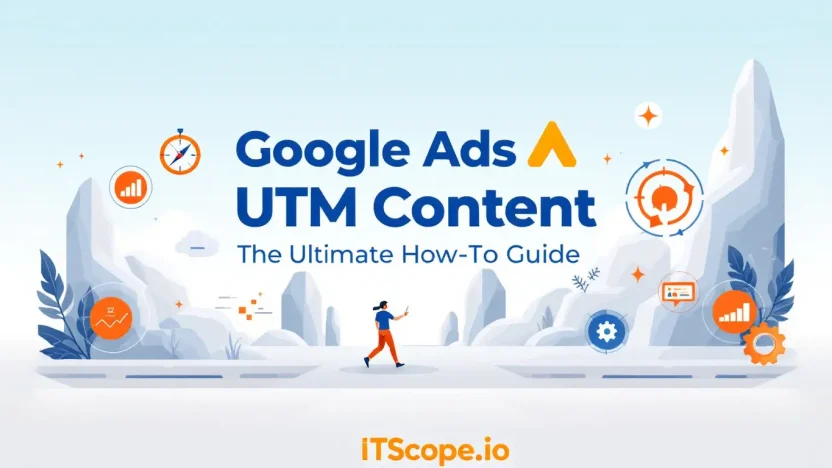Imagine unlocking the full potential of your digital marketing campaigns with just a few clicks—sounds too good to be true, right? Enter the world of Google Ads UTM Content, the powerful tool that empowers marketers to delve deep into campaign insights. By implementing UTMs, you’ll wave goodbye to vague data and welcome precise analytics that inform your strategy and optimize your ROI.
In this ultimate how-to guide, we’ll dive into everything you need to know about setting up and leveraging Google Ads UTM Content. From understanding the basics to mastering advanced techniques, this guide is packed with actionable insights that’ll transform your marketing efforts. Ready to revolutionize your campaign tracking? Let’s get started!
Table of Contents
- Understanding the Importance of UTM Parameters
- What is Google Ads UTM Content?
- Setting Up Your Google Ads UTM Content
- Analyzing Data from UTM Parameters
- Advanced Strategies for Using UTM Content
- Common Mistakes and How to Avoid Them
- FAQs
- Conclusion
Understanding the Importance of UTM Parameters
Unlocking the potential of Google Ads UTM Content begins with understanding the vital role UTM parameters play in your marketing strategy. Think of them as little tags appended to your URLs—each carrying a wealth of information about how visitors reach your site.
Why are they so important? They help you track the effectiveness of your marketing efforts, offering deep insights into traffic sources, and ultimately guiding your advertising decisions with precision. Simply put, UTM parameters empower you to attribute web traffic accurately, enabling seamless performance analysis.
Components of UTM Parameters
Let’s break down these components. You typically encounter:
- Source: Reveals where the traffic originates, like Google or Facebook.
- Medium: Indicates the means through which users arrived, such as email or PPC.
- Campaign: Specifies the campaign’s name or identity, connecting you to specific marketing efforts.
- Content: Differentiates similar content or links within the same ad to provide clarity for analysis. Learn more about how this can refine your targeting.
Tagging effectively ensures a better understanding of user interactions with your campaigns.
Consider this: Without UTM parameters, you’re missing the GPS coordinates to locate which ads drive engagement. It’s akin to sailing without a compass. Empower your strategies by integrating UTM tracking in Google Ads today.
Explore more insights on integrating these tactics into your strategies over at ITScope.io.
What is Google Ads UTM Content?
Google Ads UTM Content is a crucial component of UTM parameters used to track and analyze the effectiveness of ad campaigns on Google. Essentially, it’s a tag added to the URL that lets you identify which specific ad element drove a user to your site. This insight aids in making informed marketing decisions, helping you focus on what works.
Imagine you’ve set up multiple ads for a campaign, and you want to determine which ad copy or creative resonates most. By using a unique UTM content parameter for each ad variant, you can map out which one captures audience interest best. Discover more about Google Ads to enhance your approach.
- Example of UTM Content in a URL:
?utm_source=google&utm_medium=ads&utm_campaign=summer_sale&utm_content=header-banner - Role in Analytics: It helps break down the performance of various ad elements, letting marketers fine-tune strategies for better results.
To deepen your understanding, check out this guide on UTM parameters. For practical setup advice, explore these steps that explain how to implement UTM tracking in Google Ads effectively. Curious about the benefits? See this comprehensive overview.
Setting Up Your Google Ads UTM Content
Do you want to supercharge your campaign tracking? Setting up your Google Ads UTM content is the next step. UTM content allows you to track every detail of your ad performance. But where do you start? Let’s explore this straightforward process.
- Access Your Google Ads Account: First, navigate to your Google Ads account. Familiarize yourself with its interface to locate the right tools quickly.
- Navigate to Campaign Settings: In Google Ads, click on the campaign you want to track. Then click on “Settings” to access various customization options.
- Find UTM Parameters: Ensure you understand UTM parameters by checking resources like Admastery or explore more on Waseem Bashir’s blog. Knowing the correct parameters is essential for tracking success.
- Insert the UTM Content: Within the tracking settings, input your custom UTM content. Use the format:
?utm_source=google&utm_medium=cpc&utm_campaign=spring_sale&utm_content=ad1. Replace values to fit your specific campaign goals. - Review and Save: Double-check each parameter to ensure accuracy. Click “Save” to implement these changes immediately.
Tip: Consistently labeled UTM content helps maintain clear insights into which ads perform best.
UTM Tools
Several tools assist with UTM parameter creation, like Bread & Butter, which simplifies this setup process.
Internal tracking insights can be enhanced using ITScope’s own strategies you can explore at ITScope.io for further reading.
| Parameter | Description |
|---|---|
| utm_source | Identifies where the traffic is coming from. |
| utm_medium | Tracks the type of traffic, e.g., CPC. |
| utm_campaign | Named for tracking specific campaigns. |
Remember, setting up your Google Ads UTM content isn’t complicated but requires attention to detail. With the right setup, you’ll gain valuable insights into your campaign’s performance.
Analyzing Data from UTM Parameters
Want to unlock the full potential of your Google Ads campaigns? Understanding how to analyze data from UTM parameters is key. Mastering this can transform your digital marketing strategy and add precision to your advertising efforts.
By examining google ads utm content, you gain insights into ad performance and user behavior. Let’s break down the process:
- Access Your Analytics Tool: Use platforms like Google Analytics. Navigate to the Acquisition section where UTM data resides.
- Identify Key Metrics: Focus on sessions, bounce rates, and conversions tied to UTM parameters. These metrics shed light on which ads resonate.
- Compare Performance: Utilize tables or charts to compare different UTM labels. Visual comparisons make it easy to spot trends or anomalies.
Example Table:
UTM Content Clicks Conversions Ad A 500 50 Ad B 600 30 - Draw Conclusions: Analyze which ads and messages perform best. Are some generating more leads?
Need more insights? Check out this expert guide on maximizing your UTM data’s potential.
Still curious? Explore further reading here to dig deeper into Google Ads UTM tracking setup.
Advanced Strategies for Using UTM Content
Are you ready to take your tracking game to the next level? Understanding how to use Google Ads UTM content effectively can make all the difference in your marketing strategy. UTM tracking provides invaluable insights into your campaign’s performance, ensuring your efforts reach the desired audience effectively. But how do you leverage this tool to its full potential?
- Tailor Messages for Different Audiences: Using the UTM content parameter, segment your audience by interest and customize your ad copy to match. This way, you fine-tune your message to resonate better with distinct audience segments.
- Optimize Ad Scheduling: Track which times of day or week perform best for specific content. Use this data to schedule your ads strategically, ensuring they appear when they’re most likely to convert.
- Analyze Competitor Performance: Use insights from UTM content to gauge how competitors might be targeting similar demographics or user interests. Adapt your strategies to outmaneuver them in the marketplace.
Focusing on Google Ads UTM content helps refine marketing efforts, leading to increased ROI and a more targeted audience reach.
For more guidance, explore additional resources on setting up UTM tracking: Google Ads UTM Parameters Guide, UTM Parameters Explained, and Comprehensive UTM Setup.
Ready to dive even deeper into optimizing your Google Ads campaigns? Discover more insights on ITScope.io to empower your marketing strategies.
Common Mistakes and How to Avoid Them
When setting up , even seasoned marketers can slip up. Let’s identify frequent pitfalls and learn how to steer clear of them.
- Inconsistent Naming Conventions: A tangled web of inconsistent UTM names ensures confusion. Always stick to a predefined structure. Consider setting up a naming guideline. More on these in our related post.
- Leaving Out Key Parameters: Missing parameters can muddy your data. Double-check your setup to ensure all relevant parameters are present. Consult resources like Ad Mastery for a deeper dive.
- Failing to Test: UTM links should always be tested before launching campaigns. Use tools to verify tracking accuracy. Learn more testing tips at Waseem Bashir’s Guide.
Additional Tips
Consider using automation to streamline the tag creation process. This ensures consistency and accuracy, reducing human error.
Automating UTM generation can save time and enhance precision.
Ultimately, avoiding these mistakes not only tightens your tracking but also means making sense of your data becomes a breeze. Need more guidance? Check out these expert insights.
FAQs
What is Google Ads UTM Content?
Google Ads UTM Content is a parameter added to your ad’s URL to help you track specific promotions or advertisements within your campaigns. It allows marketers to differentiate between variants in the same campaign. Learn more about UTM parameters for Google Ads here.
How can I add UTM Content to my Google Ads?
You can add UTM Content by editing the Tracking Template in your Google Ads’ campaign settings. Append the desired UTM parameters to your URL. For detailed steps, read our guide on ITScope.io.
Why use Google Ads UTM Content?
Using Google Ads UTM Content helps you track the effectiveness of different ads and creative variations within the same campaign. It provides insights into which ads drive the most traffic and conversions. For strategic tips, check this guide.
Is Google Ads UTM Content necessary?
While not strictly necessary, using Google Ads UTM Content greatly enhances your ability to track performance at a granular level and optimize your campaigns for better ROI. More insights on the benefits can be found here.
Conclusion
Mastering Google Ads UTM content elevates your advertising strategy from guesswork to precision. By tracking campaign effectiveness, you gain clarity on what’s working. This guide has shown you the ropes, but experimentation is key. Stay curious. Apply what you’ve learned, and your marketing efforts will flourish. For further reading, explore expert insights from Ad Mastery, Waseem Bashir, and Bread & Butter.



